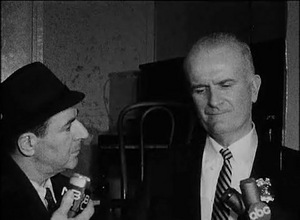This is an archive of the ArtCat Zine, 2007-2009. Please visit our new project, IDIOM.
Ken Jacobs' "Perfect Film"
In Ken Jacobs' Perfect Film, 1985, we see what looks to be two unedited sound interviews on sharp black and white film, both recorded in single, long takes. The scene is quickly revealed to be New York, the year is 1965. Malcolm X, the sometimes polarizing African American human rights activist has just been fatally shot in the Audubon Ballroom, in Manhattan's Washington Heights. We see unfold the observations and reactions of two men on screen as they answer questions that come from on- and off screen interlocutors. The first is an unidentified African American Harlem resident who speculates on Malcolm X's importance to America and the Harlem race riots that had just transpired the summer before. The second interview meanwhile is between a number of journalists and an unidentified white police inspector in a suit and striped tie whose responses to the questions asked seem to shift from edgy to flat. With the two interviews come the various subtle austerities of raw film footage: we see a false start, each subject's preparation for the camera, an inappropriate grin, a pregnant silence.
Following the two interviews is a cut to silence as we see various street scenes, images around and inside the Audubon, and finally, interior views of the apparent scene of the crime where a police officer points with a nightstick at a marker on the floor while camera flashes fill the room with light. The film is something of a time capsule of course, and has all the weight of a historical document, which it certainly is. First, for Jacobs, who found the footage in 1985 -- several discarded news rushes arbitrarily spliced together and sold to the filmmaker for the price of the reel they ware on -- and secondly for the contemporary viewer, who encounters images so heavy with historic residue that the filmmaker himself, who had not otherwise shied away from the use and manipulation of found-footage, judged the raw film perfect, requiring no intervention on the editing table whatsoever. Jacobs' decision to put the orphaned images back into circulation, framed now only by a title, has resulted in a complex and arresting work. It is a film that one might imagine, without great difficulty, inspiring a generation of certain certain younger media makers like Walid Raad and Matthew Buckingham.
Jacobs writes on the film:
I wish more stuff was available in its raw state, as primary source material for anyone to consider, and to leave for others in just that way, the evidence uncontaminated by compulsive proprietary misapplied artistry, "editing", the purposeful "pointing things out" that cuts a road straight and narrow through the cine-jungle; we barrel through thinking we’re going somewhere and miss it all. Better to just be pointed to the territory, to put in time exploring, roughing it, on our own. For the straight scoop we need the whole scoop, or no less than the clues entire and without rearrangement. O, for a Museum of Found Footage, or cable channel, library, a shit-museum of telling discards accessible to all talented viewers/auditors. A wilderness haven salvaged from Entertainment.
Perfect Film is one of twenty works currently being shown by the online film and video exhibitor tank.tv. A major exhibition curated by Mark Webber and spanning just over 50 years of work, the show includes several upcoming events in London and Amsterdam, and will remain on view at tank.tv's website through 30 November, 2008.
ZINE
HOME
TIPS / COMMENTS
CATEGORIES
CONTRIBUTORS
- Greg Afinogenov
- B. Blagojevic
- Adda Birnir
- Susannah Edelbaum
- Julie Fishkin
- Paddy Johnson
- Jessica Loudis
- Christopher Reiger
- Andrew Robinson
- Peter J. Russo
- Blythe Sheldon
- S.C.Squibb
- Hrag Vartanian

